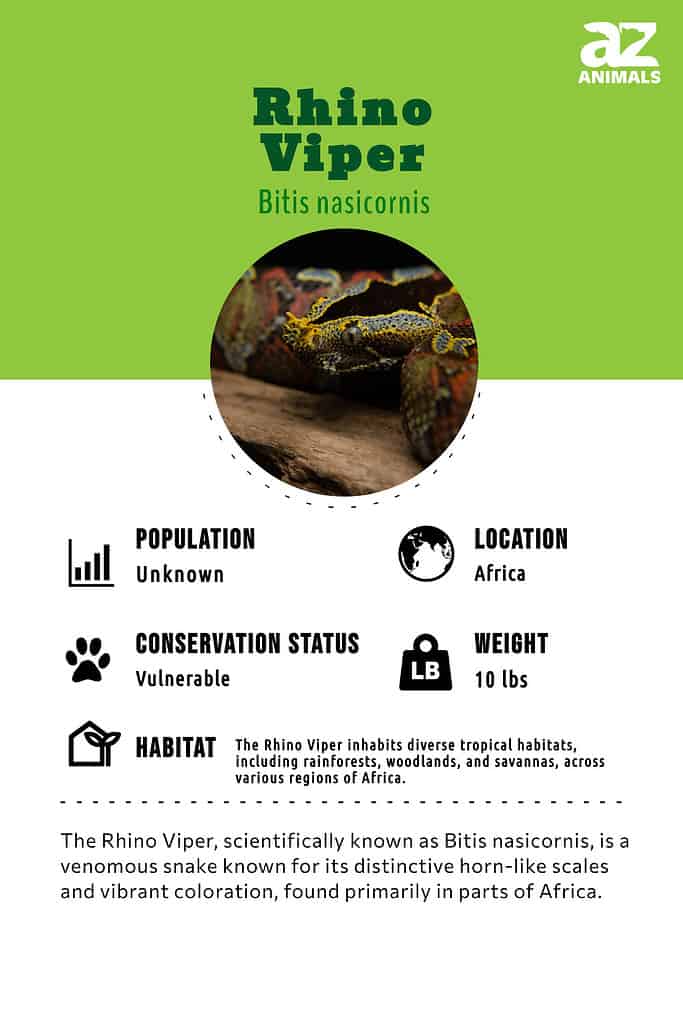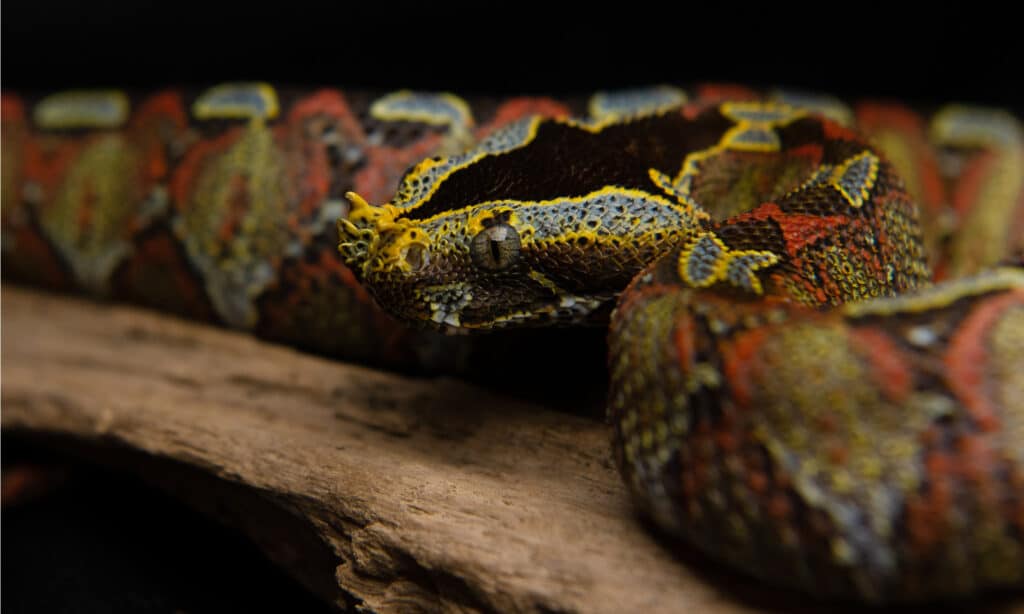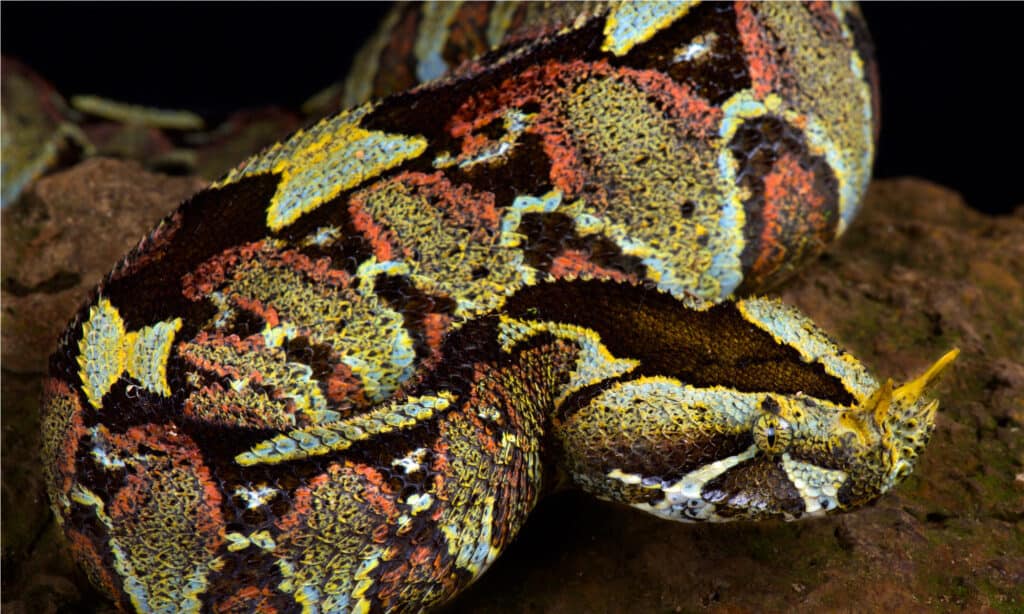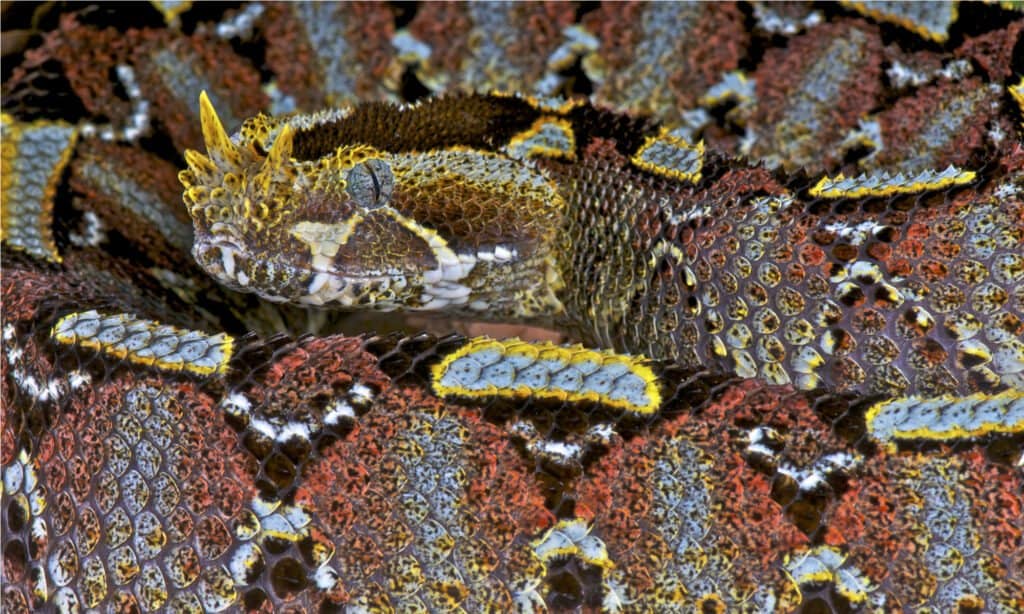Rhino Viper
Bitis nasicornis
The river jack snake has a gigantic horn-like scale on the tip of its nose.
Advertisement
Rhino Viper Scientific Classification
- Kingdom
- Animalia
- Phylum
- Chordata
- Class
- Reptilia
- Order
- Squamata
- Family
- Viperidae
- Genus
- Bitis
- Scientific Name
- Bitis nasicornis
Read our Complete Guide to Classification of Animals.
Rhino Viper Conservation Status
Rhino Viper Facts
- Fun Fact
- The river jack snake has a gigantic horn-like scale on the tip of its nose.
- Average Litter Size
- 6-35 eggs
- Common Name
- River jack snake
View all of the Rhino Viper images!

The river jack snake has a gigantic horn-like scale on the tip of its nose.
The rhino viper, also known as the river jack snake and the butterfly viper, is among the most unique-looking snakes in the world.
With their forward-set eyes and complex markings, the head actually looks more like a gecko or lizard than a snake.
Because they tend to live in such remote locations, river jacks are rarely encountered by people.
5 River Jack Snake Amazing Facts

Although the exact lifespan of the river jackfish is not extensively documented, it is generally believed to average around eight years based on estimates.
©Olivia Lundborg/Shutterstock.com
- After mating, the female river jack gives birth to live baby snakes in the rainy season between March and April. She will produce a clutch of six to 35 young at a time. The baby snakes will emerge from the womb with their complex markings and the ability to produce venom. They measure about 7 to 10 inches long at the start of their lives.
- The lifespan of the river jack is not well-known, but it’s been estimated to be about eight years on average.
- The river jack has hinged fangs that fold back up into the roof of the mouth. It also has the ability to control the movement of its fangs. Like other types of vipers, the river jack will tend to shed its fangs once every six to 10 weeks.
- River jacks appear brightest immediately after shedding their skin. The bright colors usually fade quickly from the dirt and silt accumulating on their body.
- River jacks have the ability to climb trees thanks to their partially prehensile tail. They are also said to be very strong swimmers in the water.
Where to Find Them

River jack snakes can be encountered across the lush tropical forests of Central and West
Africa
.
©reptiles4all/Shutterstock.com
River jack snakes are found throughout the tropical forests of Central and West Africa. They usually stay in close proximity to a swamp, lake, or pond, where they often bask in the water.
They are most commonly found in countries like the Republic of Congo, the Democratic Republic of Congo, Gabon, and Cameroon. However, the Western population is cut off from the Central population by a gap in the forest cover.
Evolution and Origins
The Rhinoceros Viper (Bitis nasicornis) belongs to the viper family and is classified as a vulnerable species by the IUCN.
Indigenous to Ethiopia, these snakes reproduce sexually and exhibit distinct differences in size compared to Gaboon vipers, with Gaboon vipers reaching lengths of up to seven feet while rhino vipers typically reach a maximum length of four feet.
Notably, the key distinguishing feature between the two species is the significantly larger size and weight of Gaboon vipers in comparison to rhino vipers.
The venom of the rhino viper has a destructive effect on the circulatory system of its prey, causing damage to tissues and blood vessels, leading to internal bleeding.
Additionally, the fangs of the rhino viper remain folded against the roof of its mouth when they are not actively being used.
Scientific Name
The scientific name of the river jack snake is Bitis nasicornis. This name may be derived from the Latin word nasus, meaning nose, which refers to the prominent horn on the end of the head. The river jack is most closely related to the puff adder, horned adder, and other species in the Bitis genus.
Population and Conservation Status
According to the IUCN Redlist, the river jack is a vulnerable species. Population numbers have not been properly estimated, but overall the species appears to be in decline. The greatest threat to its continued survival appears to be habitat destruction and deforestation.
How to Identify Them: Appearance and Description

The river jack snake stands out with its distinctive appearance, making it relatively straightforward to identify.
©reptiles4all/Shutterstock.com
The river jack snake is fairly easy to identify thanks to its completely unique appearance. It has a short but stout body with a triangle-shaped head and rough, keeled scales from head to tail. The eyes also project outward from the head.
Most specimens measure about 2 or 3 feet long, but some can grow up to 4 feet. Females are slightly larger than males on average, but otherwise, their appearance is similar to each other. The most prominent characteristic is the two or three large horns extending from the end of the nose. It is not entirely clear what purpose this serves.
The color pattern is a fascinating, almost painterly combination of a yellowish-white or bluish-green stripe down the back mixed intermittently with dark brown oblong markings. The flanks are equally interesting in the alteration between dark and light patterns.
The markings vary among individuals and depend largely on the snake’s habitat. They provide camouflage to protect the snake from dangerous predators and also veil it from prey. An immobile river jack is very hard to identify against the forest floor. Baby river jack snakes have an immature version of the same color pattern.
Here is a quick rundown of how to identify the river jack snake:
- Short but stout body measuring up to 4 feet long
- Rough, keeled scales
- Triangle-shaped head
- Two or three large horns on the nose
- Bulging eyes
- Unique brown markings all around the body
How Dangerous Are They?
The river jack snake is capable of producing two different types of dangerous venom.
One type attacks the circulatory system of its prey, destroys tissue, and causes extensive hemorrhaging. The other type directly attacks the nervous system, but in humans, this is far less potent than the other venom.
If bitten, medical attention should be sought immediately. The venom is considered to be quite potent. Massive swelling and even, in rare cases, necrosis can occur. Fortunately, anti-venom for this snake is available, and death is rare.
Behavior and Humans
The river jack snake is generally quite slow-moving and not very aggressive, but if provoked in some manner, it will usually puff up its body and give a loud hiss.
River jacks have the ability to strike out quickly in self-defense and bite with their sharp fangs. Their reach extends up to half their body length in every direction.
Due to their limited territorial range, few attacks on people are known to occur. They prefer to inhabit remote forests and swamps. However, they should still be considered highly dangerous and potentially aggressive.
They are difficult to handle because their prehensile tail gives them the ability to swing around and strike when being held.
View all 114 animals that start with RRhino Viper FAQs (Frequently Asked Questions)
Are river jack snakes venomous?
Yes, the river jack can produce harmful venom that has the ability to damage tissue and even kill. This venom is a combination of neurotoxins (which attack the nervous system) and hemotoxins (which attack red blood cells and the rest of the circulatory system).
How do river jack snakes hunt?
The river jack usually lies motionless along the ground and ambushes prey as they wander by. The snake will strike quickly and inject venom with its fangs. If the prey cannot be easily swallowed whole in a single bite, then the snake may wait several minutes for the venom to fully work. The venom kills small prey quickly due to massive bleeding.
Are river jack snakes aggressive?
The river jack is rarely aggressive unless directly provoked. But if they do feel threatened, then they will give their warning display and then bite.
Where do river jack snakes live?
River jacks normally live deep within tropical forests and swamps.
What do river jack snakes eat?
The river jack primarily consumes rodents, frogs, fish, and various small mammals around its territory.
What is a river jack snake?
The river jack is a unique-looking snake, easily identified by the complex color scheme and the two or three large horns on its nose. It belongs to the viper family, which are primarily defined by their hinged fangs and toxic venom.
What does rhino viper venom do?
The venom attacks the circulatory system and destroys blood vessels. At its worst, the venom is known to cause extensive bleeding. It can also attack the nervous system.
Are the river jack snake and rhino viper the same thing?
Yes, river jack and rhino viper are different names for the same species. Rhino viper was once the most commonly used name, but it was deemphasized in favor of the river jack snake after leading to some confusion with the West African gaboon viper, which goes by the scientific name Bitis rhinoceros. Butterfly viper is actually preferred among some experts. River jack is kind of an informal name.
Where are river jack snakes found?
They are found in various countries throughout Central and Western Africa.
What is the difference between a Gaboon viper and a rhino viper?
The key difference between the Gaboon viper and the rhino viper is that Gaboon vipers are significantly larger and heavier than rhino vipers.
Read about the other differences here.
Thank you for reading! Have some feedback for us? Contact the AZ Animals editorial team.


















